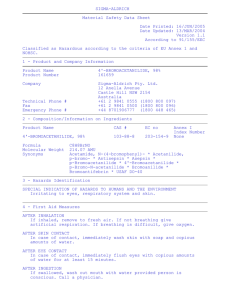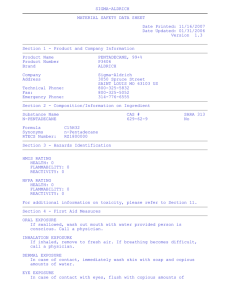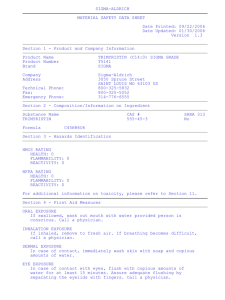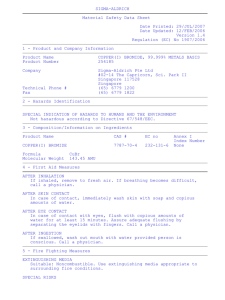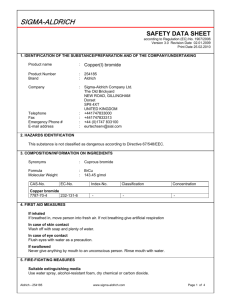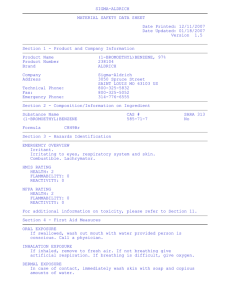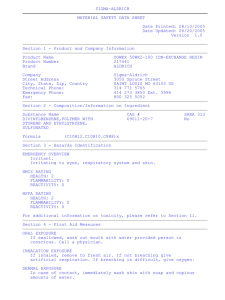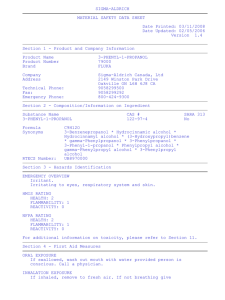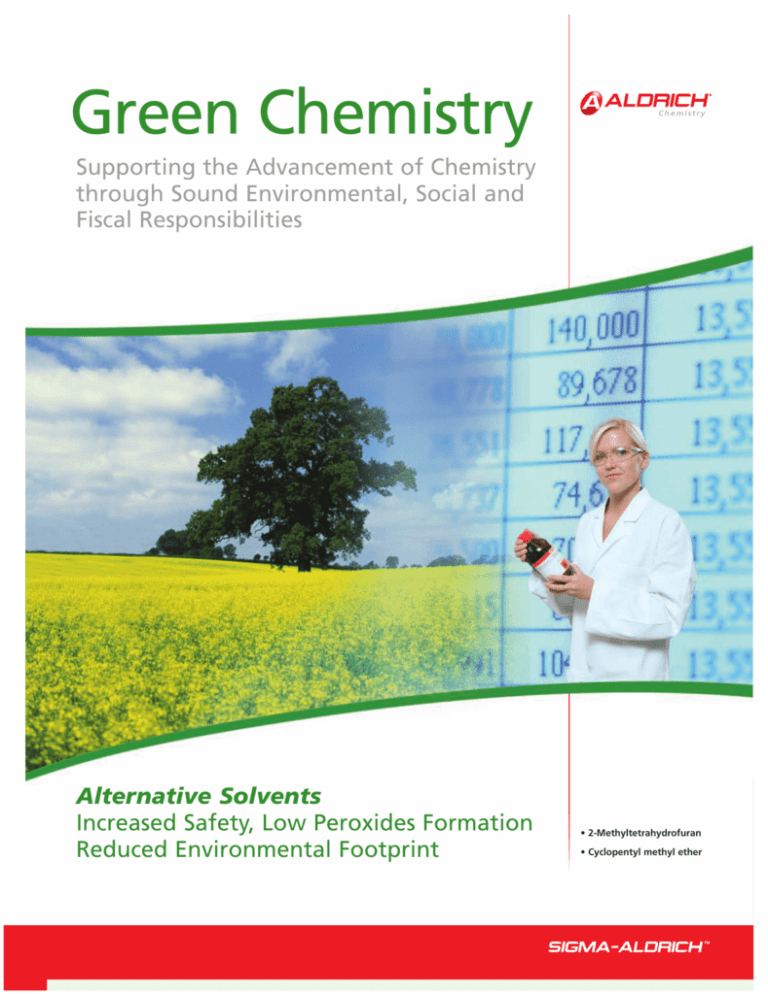
Green Chemistry
Supporting the Advancement of Chemistry
through Sound Environmental, Social and
Fiscal Responsibilities
Alternative Solvents
Increased Safety, Low Peroxides Formation
Reduced Environmental Footprint
3704 Green Chemistry_v2.indd Sec1:1
• 2-Methyltetrahydrofuran
• Cyclopentyl methyl ether
10/31/2007 2:33:51 PM
Green Chemistry
The aim of green chemistry is to reduce chemical
related impact on human health and virtually eliminate
contamination of the environment through dedicated,
sustainable prevention programs. Green chemistry searches
for alternative, environmentally friendly reaction media
and at the same time strives to increase reaction rates and
lower reaction temperatures.
The green chemistry concept applies innovative scientific
solutions to solve environmental issues posed in the
laboratory. Paul T. Anastas, an organic chemist working in
the Office of Pollution Prevention and Toxins at the EPA,
and John C. Warner developed the Twelve Principles
of Green Chemistry in 1991. These principles can
be grouped into Reducing Risk and Minimizing the
Environmental Footprint.
2-Methyltetrahydrofuran (2-MeTHF)
CAS No.: 96-47-9
A Truly Green Alternative to Dichloromethane and Tetrahydrofuran
2-MeTHF is manufactured from such by-products of agricultural waste
as corncobs and bagasse. It is more stable than THF in the formation of
peroxides, however a stabilizer is required.
Features & Benefits
• Completely miscible in water
• Quickly produces clean water phase splits (density
of 0.86 g/mL at 25 °C) without forming emulsions
• More easily dried than THF or DCM
• Very stable even in highly acidic environments
• Non-reactive, aprotic polar solvent
• Forms an effective azeotrope with water
• Higher boiling point (78–80 °C)
• Lower solvent loss during reflux
2-Methyltetrahydrofuran
Cat. No.
Anhydrous, ≥99.0% Contains 250 ppm BHT
414247-100ML
Anhydrous, ≥99.0% Inhibitor-free
ReagentPlus®, ≥99.9% Contains 250 ppm BHT 2
sigma-aldrich.com
3704 Green Chemistry_v2.indd Sec1:2
Alternative to Tetrahydrofuran for
Organometallic Reactions
• Grignard
• Reformatskii (Reformatsky)
• Lithiation
• Hydride Reduction
• Metal-Catalyzed Coupling (Heck, Stille, Suzuki)
Alternative to Dichloromethane for
Biphasic Reactions
• Alkylation
• Amidation
• Nucleophilic Substitution Reaction
414247-1L
414247-6X1L
414247-2L
414247-4X2L
414247-200L-P2
673277-100ML
For more information on our 200 L
Returnable Container, please visit us
at sigma-aldrich.com/rc.
673277-12X100L
673277-1L
673277-200L-P2
155810-100ML
155810-12X100ML
155810-500ML
155810-4X4L
155810-20L
ORDER: 800-325-3010
TECHNICAL SERVICE: 800-325-5832
10/31/2007 2:33:59 PM
The Sigma-Aldrich Global Commitment
Sigma-Aldrich has a proud tradition of sound
environmental, social and fiscal responsibility.
We are committed to sustainable growth which
is good for the environment, our people, and
our customers.
Cyclopentyl methyl ether (CPME)
CAS No.: 5614-37-9
Safe, Environmentally Friendly Alternative to Tetrahydrofuran,
1,4-Dioxane and 1,2-Dimethoxyethane
CPME provides a green solution for those looking to improve their chemical
process. Using CPME is an environmentally sound choice, not only by
reducing energy waste, but its low water solubility limits it as a potential
environment contaminate.
Features & Benefits
• More stable than THF when it comes to forming peroxides
• Does not require the addition of a stabilizer
• Higher boiling point (106 °C)
• Relative stability under acidic and basic conditions
• Formation of azeotropes with water
• Narrow explosion range
• Conventional drying is unnecessary for general
organometallic reactions
Cyclopentyl methyl Ether
Anhydrous, ≥99.9%
Cat. No.
675970-100ML
675970-1L
675970-2L
ReagentPlus®, ≥99.9% 675989-500ML
675989-1L
675989-4L
CPME is a proven alternative
to THF, providing better yields
and higher selectivity.
CPME Applications
Higher Optical Purity or Selectivity were Observed
• Asymmetric Michael Alkylation
• Michael addition of R2CuLi
• Alkylation of chiral amide
• Glycosidation
• Asymmetric hydrogenation of NaBH4
• Hydrosilylation by Ru cat
Nucleophilic Reactions
• Amide synthesis by the reaction of acid chloride
with amine
• Sillylation and desillylation
• Reaction of Carbon anion with aldehyde
• Debenzylation
• Alkylation of amine
• Selective methylation of phenols
• Bromination of alcohol with PBr3
• Sulfonylchloride synthesis by the reaction of sulfonic acid with PCl5
Reactions using Metals
• Reaction of ketone using NaBH4
• Reaction of acetylenes with Ti(OR)4
• Reaction using n-BuLi or Lithium Diisopropyl Amide
• Radical cyclization of trichloroacetate using Cu cat
• Reduction of ethyl benzoate using Lithium Aluminium Hydride
• Formation of sodium dispersion
• Intramolecular ene reaction using ZnCl2
3
3704 Green Chemistry_v2.indd Sec1:3
3
10/31/2007 2:34:08 PM
Physical Properties of Solvents
Properties
Stabilizer Required
CPME
2-MeTHF
THF
Ether
DCM
1,4-Dioxane
MTBE
No
Yes
Yes
Yes
Yes
No
No
Density (20 °C) [g/cm3]
0.86
0.86
0.89
0.71
1.32
1.03
0.74
Dielectric constant (25 °C)
4.76
6.97
7.58
4.197
8.93
2.227
—
Boiling point [°C]
106
80
65
34.6
39.8
101
55
Heat of Vaporization
(bp)[Kcal/kg]
69.2
87.1
98.1
86.1
80.5
98.6
81.7
Solubility of Solvent in Water
(23 °C) [g/100g]
1.1
4.1
Infinite
6.5
1.3
Infinite
4.8
Solubility of Water in Solvent
(23 °C) [g/100g]
0.3
14.4
Infinite
1.2
0.2
Infinite
1.5
Azeotropic temperature with
Water [°C]
83
89
64
34
39
88
52
Flash point [°C]
–1
–11.1
–14.2
–45
—
12
–28
1.1% / 9.9%
—
1.84% / 11.8%
1.85% / 48%
14% / 22%
2% / 22%
1.6% / 15.1%
Explosion range [vol%]
Lower / Upper limit
Peroxide Formation of Ether Solvent
250
Rate of Peroxide
Formation by days (x)
Y = 0.2033x
THF Stabilized
Y = 0.8218x
THF
Y = 15.277e0.0962x
Peroxide wt ppm
CPME
200
150
100
50
0
0 1 2 3 4 5 6 7 8 9 10 11 12 13 14 15 16 17 18 19 20 21 22 23 24 25 26 27 28 29 30
Days (x)
Conditions
• 20 mL of each sample in a brown bottle (capacity of 65 mL)
• Stored at room temperature, in a dark place and in the presence of air
CPME is a product of Zeon Corporation with approval by Toxic Substances Control Act (TSCA) and European List of Notified Chemical Substances (ELINCS).
Check out the new
Spec Comparison page
to find the perfect Sigma-Aldrich
solvent for your application.
sigma-aldrich.com/solvents
World Headquarters
Order/Customer Service (800) 325-3010 • Fax (800) 325-5052
3050 Spruce St., St. Louis, MO 63103
(314) 771-5765
sigma-aldrich.com
Technical Service (800) 325-5832 • sigma-aldrich.com/techservice
Development/Bulk Manufacturing Inquiries
(800) 244-1173
©2007 Sigma-Aldrich Co. All rights reserved. SIGMA, , SAFC,
, SIGMA-ALDRICH, ALDRICH, , FLUKA, , and SUPELCO,
are trademarks belonging to Sigma-Aldrich Co.
and its affiliate Sigma-Aldrich Biotechnology, L.P. Sigma brand products are sold through Sigma-Aldrich, Inc. Sigma-Aldrich, Inc. warrants that its products conform to the information
contained in this and other Sigma-Aldrich publications. Purchaser must determine the suitability of the product(s) for their particular use. Additional terms and conditions may apply.
Please see reverse side of the invoice or packing slip.
Printed on Recycled Paper —
A Worldwide Operation with a Global Commitment
03704
0107
sigma-aldrich.com
ORDER: 800-325-3010
TECHNICAL SERVICE: 800-325-5832
Accelerating Customers’ Success through Leadership in Life Science, High Technology and Service
3704 Green Chemistry_v2.indd 1
10/31/2007 2:33:40 PM


